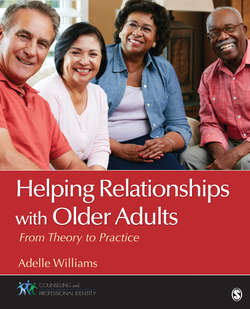Читать книгу Helping Relationships With Older Adults - Adelle M. Williams - Страница 65
На сайте Литреса книга снята с продажи.
References
ОглавлениеBayer, A., & Harper, L. (2009). Fixing to stay: A national survey on housing and home modification issues. Washington, DC: American Association of Retired Persons.
Bernard, D. (2013). The impact of baby boomers working past 65. Retrieved from http://money.usnews.com/money/on-retirement/2013/01/18/the-impact-of-baby-boom
Brooks, D. (2000). Bobos in paradise: The new upper class and how they got there. New York, NY: Touchstone.
Brownell, W., Mundorf, N., & Mundorf, J. (2006). Images of aging. In R. Schultz, N. Noelker, K. Rockwood, & R. Sproh (Eds.), The encyclopedia of aging (4th ed). New York, NY: Springer.
Collinson, C. (2014). Baby boomer workers are revolutionizing retirement: Are they and their employers ready? 15th Annual Transamerica Retirement Survey. New York, NY: Transamerica Center for Retirement.
Day, T. (2014). About the aging network. National Care Planning Council. Retrieved from www.longtermcarelink.net
Dennis, H., & Thomas, K. (2007). Ageism in the workplace. Generations, 31, 1.
Discrimination. (2015). In Merriam-Webster.com. Retrieved from http://www.merriam-webster.com/dictionary/discrimination
Erikson, E. H. (1959). The healthy personality. Psychological Issues, 1, 50–100.
Estrine, J., Nyberg, J., & Muller, C. (2001). Old and poor in America. New York, NY: International Longevity Center.
Ewing Marion Kauffman Foundation. (2011). The coming of entrepreneurship boom. Retrieved September 22, 2011, from http://www.Kaufman.org/research-and-policy/the-coming-entrepreneureal-boom.aspx
Freedman, M. (2002). Prime time: How baby boomers will revolutionize retirement and transform America. New York, NY: Public Affairs.
Gartska, T. A., Schmitt, M. T., Branscombe, N. R., & Hummert, M. L. (2004). How young and older adults differ in their responses to perceived age discrimination. Psychology and Aging, 19, 326–335.
Goldsmith, J. (2008). The long baby boom: An optimistic vision for a graying generation. Baltimore, MD: The Johns Hopkins University Press.
Green, B. (2003). Marketing to leading-edge baby boomers. New York, NY: Paramount Market.
Hess, T. M. (2006). Attitudes toward aging and their effects in behaviors. In J. E. Birken & K. W. Schaire (Eds.), Handbook of the psychology of aging (pp. 379–406). San Diego, CA: Academic Press.
Hess, T. M., Hinson, J. T., & Stratham, J. A. (2004). Explicit and implicit stereotype activation effects on memory: Do age and awareness moderate the impact of priming? American Psychological Association, 19(3), 495–505.
Hilt, M., & Lipschultz, J. (2004). Elderly Americans and the Internet. E-mail, television news, information and entertainment. Educational Gerontology, 30, 57–72.
Hogstel, M. O. (2001). Gerontology: Nursing care of the older adult. New York, NY: Delmar Cengage Learning.
Institute of Medicine. (2012). The mental health and substance use workforce for older adults: In whose hands? Retrieved from http://www.iom.edu/Reports/2012/The-Mental-Health-and-Substance-Use-Workforce-for-Older-Adults.aspx
Johnson, M., & Johnson, C. (2010). Generations, Inc.: From boomers to linksters—managing the friction between generations at work. Retrieved from AMA.com.
Karel, M. J., Gatz, M., & Smyer, M. A. (2012). Aging and mental health in the decade ahead: What psychologists need to know. American Psychologist, 67(3), 184–198.
Kite, M. E., Stockdale, G. D., Whitley, B. E., Jr., & Johnson, B. T. (2005). Attitudes toward younger and older adults: An updated meta-analytic review. Journal of Social Issues, 61, 241–266.
Knickman, J. R., & Snell, E. K. (2002). The 2030 problem: Caring for aging baby boomers. Healthy Services Research, 37(4), 849–884.
Lancaster, L., & Stillman, D. (2003). When generations collide: Who they are: Why they clash. How to solve the generational puzzle at work. New York, NY: Harper.
Levy, B. (2002). Longevity increased by positive self-perceptions of aging. Journal of Personality and Social Psychology, 83(2), 261–270.
Mermin, G., Johnson, R. W., & Toder, E. (2008). Will employers want aging boomers? Washington, DC: Urban Institute.
Monsees, C. V. (2002). Ageism. Encyclopedia of aging. Retrieved from http://www.encyclopedia.com/topic/Ageism.aspx
Moody, H. R., & Sasser, J. R. (2012). Aging concepts and controversies (7th ed.). Thousand Oaks, CA: Sage.
National Academy on an Aging Society. (2001, February). What are the attitudes of young retirees and older workers? Washington, DC: Author.
Okrent, D. (2000, June). Twilight of the boomers. Times. Retrieved from http://www.time.com/time/magazine/article10.9171,997133.00.html
Prejudice. (2015). In Oxford Dictionary online. Retrieved from http://www.oxforddictionaries.com/us
Palmore, E. B. (2004). The future of ageism. New York, NY: International Longevity Center—USA.
Rogoff, E., & Carroll, D. (2009). The second chance revolution: Becoming your own boss after 50. New York, NY: Rowhouse.
Ronch, J. L., & Goldfield, J. A. (2003). Mental wellness in aging: Strengths-based approaches. Baltimore, MD: Health Professions Press.
Ronch, J. L., & Maizler, J. S. (1977). Individual psychotherapy with the institutionalized aged. Detroit, MI: American Orthopsychiatric Association.
Smith, P. R. (2014). A historical perspective in aging and gerontology. In H. F. O. Vakalahi (Ed.), The collective spirit of aging across cultures, international perspectives on aging. doi:1007/978–94–017–8594–5-2
Steinhorn, L. (2006). The greater generation: In defense of the baby boom legacy. New York, NY: St. Martin’s Press.
Uhlenberg, P. (2000). Integrating of old and young. Gerontologist, 40(3), 276–279.
U.S. Census Bureau, American Community Survey. (2009). Educational attainment in the United States: 2009 Population characteristics. Current Population Reports, Washington, DC.
U.S. Census Bureau. (2014a). Current population survey. A profile of older Americans: 2014. Retrieved from http://www.aoa.acl.gov/aging_statistics/profile/2014/docs/2014-Profile.pdf
U.S. Census Bureau. (2014b). Population estimates and national projections. Retrieved from http://www.census.gov/population/projections/data/national/2014.html
U.S. Department of Health and Human Services. (2015). Administration on Aging (AOA): Long-term care ombudsman program. Retrieved from http://www.aoa.acl.gov/AOA_Programs/Elder-Rights/Ombudsman/index.aspx
Vaillant, G. E. (2003). Aging well: Surprising guideposts to a happier life from the Landmark Harvard Study of Adult Development. New York, NY: Little, Brown and Co.
Walsh, M. W. (2001, February 26). Reversing decades-long trend, Americans retiring later in life. New York Times, Section A, p. 1.
Zapolsky, S. (2003). American Association of Retired Persons. Retrieved from www.aarp.org
